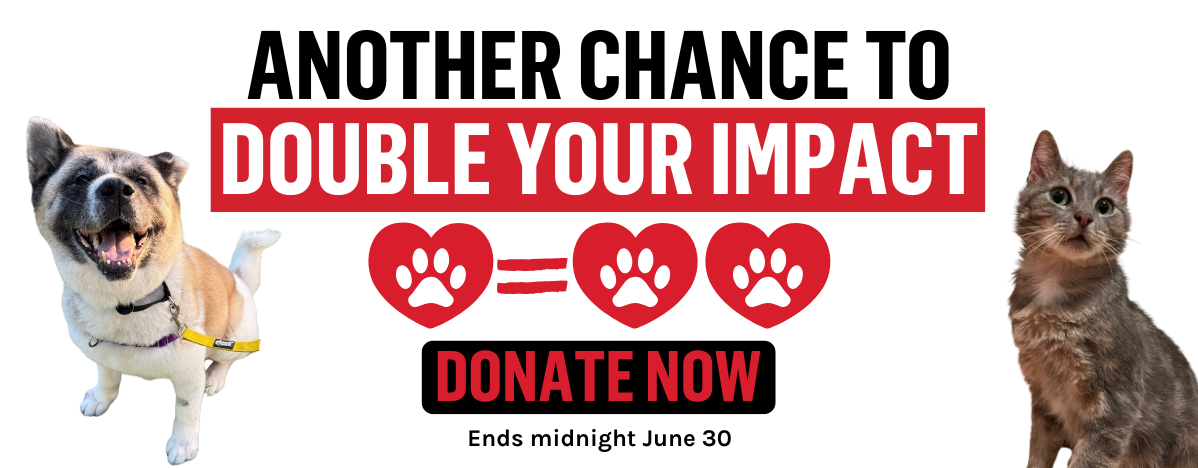BLOG
Vaughn’s Return and Earn Fundraiser
 An 11-year old South Sydney boy named Vaughn has collected over 3,000 recyclable containers since June to Return and Earn for Sydney Dogs & Cats Home.
An 11-year old South Sydney boy named Vaughn has collected over 3,000 recyclable containers since June to Return and Earn for Sydney Dogs & Cats Home.
Vaughn’s fundraiser started as a collections box in his front yard, quickly growing into a community initiative, with locals like Mark Coure MP hearing word and making donations.
Vaughn’s mother Barbara said Facebook and her existing connections were key in the success of the fundraising drive.
“We posted about it in a local community group Mark Coure was part of and he got the ball rolling, visiting our home with some money to put towards Vaughn’s drive,” she said.
“I’m a teacher and had some connections already, so I made some calls to get the community involved.”
Locals including Councillor Sam Elmir, Councillor Sandy Grekas, Kogarah Cougars Rugby League Club, Cup and Cook Kyle Bay and Gavan Property got involved with Vaughn’s drive, donating recyclable containers and money.
Vaughn said the fundraiser was part of a school project to serve his community, so he chose to help the charity who helped get his dog home in 2018.
“Our dog wouldn’t stop jumping over the fence and when she was lost, unlike other pounds, Sydney Dogs & Cats Home wouldn’t rest until she was home,” he said.
Vaughn’s drive earned $500, with each container earning 10c at Return and Earn points in NSW.
Sydney Dogs & Cats Home General Manager Mark Hearnden said the shelter is extremely grateful for Vaughn’s fundraiser.
“We were so excited to hear about Vaughn’s drive, especially how it has been bringing the community together to support our shelter and its furry residents,” he said.
“As we’re Sydney’s only charity pound and community facility, every dollar Vaughn has donated is going to make a huge difference for the lost, abandoned and often neglected pets who come through our doors.”
Vaughn’s fundraiser ended on 31 October, but he is excited to make it bigger and better next year.
Vaughn will soon visit Sydney Dogs & Cats Home to meet some of the furry residents and see his donation in action.
Published 3 November 2020
Resolving Motley’s Ringworm
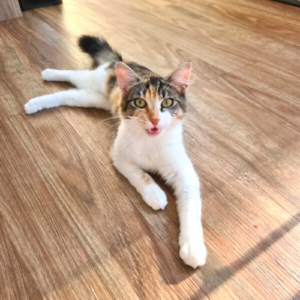 When cats arrive at the Home, they go through routine health checks and procedures to ensure they’re happy and healthy before going to their new homes. This is so we can identify issues like ringworm, which was affecting Motley when she came into our care in August.
When cats arrive at the Home, they go through routine health checks and procedures to ensure they’re happy and healthy before going to their new homes. This is so we can identify issues like ringworm, which was affecting Motley when she came into our care in August.
Ringworm is a common fungal infection in cats that can cause hair loss and adverse reactions such as dermatitis. It’s also contagious and can be passed onto humans, which we thought would make it difficult to find a foster carer for Motley.
Fortunately, we have a community of foster carers who consistently go above and beyond for our cats, and Motley was in foster care within days of her diagnosis.
Not only did Motley’s foster carer commit to consistent ringworm treatment, personal protective equipment and all, she also helped Motley come out of her shell. Motley has started to approach her human for pats and playtime, and show her affectionate personality.
Motley will soon come back into the Home to check the progress of her treatment. If resolved, she’ll soon be desexed and become available for adoption!
Narla’s Year in Care Comes to a Happy End
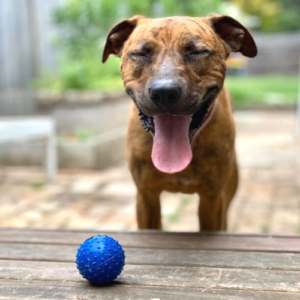 After over one year in our care, we’re pleased to announce our gorgeous Narla has found her forever home!
After over one year in our care, we’re pleased to announce our gorgeous Narla has found her forever home!
Narla arrived in August 2019 with a council ranger as a very curious young girl. It was clear she was very intelligent and friendly and would make a beautiful companion, but with a few behavioural quirks and such an active personality, it proved difficult to find her a suitable home.
While Narla waited for the right family to come along, she went into wonderful foster homes with our volunteers Robert, Sam and Stef, who went above and beyond to give Narla an exciting and active lifestyle, and help with her training.
As time went by, it became clear Narla just wasn’t meant to be a city girl, so we started investigating rescue options in more regional areas.
Stef was integral in finding a rescue for Narla and got in touch with Albury Wodonga Animal Rescue (AWAR), who agreed to take Narla into their care. Both Stef and our volunteer Sandra drove her all the way to her new temporary home.
Just a few months on, Narla has already attracted a new family out in Albury and is on a trial adoption in what will hopefully be her forever home!
Thank you to Robert, Stef, Sam, Sandra, AWAR and all the committed volunteers who supported Narla’s long journey to find her happily ever after.
Congrats Narla! 👏
The Stars Align for Aries
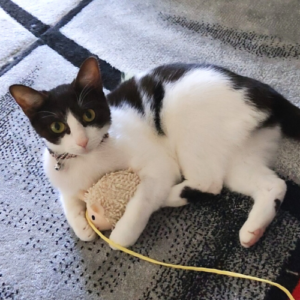 Aries appeared to be a happy, healthy cat when she was surrendered into our care in June. She passed standard health checks with ease and was sent to our adoption partner PETstock, where she could meet potential adopters and find a forever home.
Aries appeared to be a happy, healthy cat when she was surrendered into our care in June. She passed standard health checks with ease and was sent to our adoption partner PETstock, where she could meet potential adopters and find a forever home.
Then, shortly after Aries left the Home, the PETstock team noticed changes in her urine. It was showing blood. We promptly organised to bring Aries back to the Home for an extra health check, when our vet noticed she’d developed a large, fluid-filled swelling on her neck. We tested the fluid and the results suggested she had a growth called a follicular cyst. This is a benign mass that wouldn’t normally cause harm, but given its size and location, we knew it could potentially interfere with important structures in the neck if it were to continue growing. Our vet team moved quickly to get Aries into surgery and remove the cyst, making sure not to damage important structures of the neck.
Lab tests confirmed the cyst was gone for good and Aries got the all clear. She recovered with ease at the Home, sporting the most majestic mullet, which had been skilfully shaved for her surgery.
With such a slick hairdo, it didn’t take Aries long to find a forever home. She was adopted in early August by Priyanka and Kishore and has taken very well to her new family.
Priyanka tells us:
“Aries is my husband’s first pet. I can’t even believe that he is taking care of Aries more than me.
She was bit shy and scared at first, but she started becoming friendly after two weeks. When she wakes up, she needs cuddling. She starts rolling on carpet and asking me to pat her.
Aries loves tuna… Before feeding she starts rubbing her face against my hand (sometime it’s hard to give food!). She wants to play after her breakfast and it’s a must. She loves her birdie dongle & mouse.
She loves to chill with us on the sofa (but she prefers to keep some distance!). When I am taking a shower, she will sit outside near the bathroom door and start missing me. Sometimes she loves to play by herself.
Aries has her kneading pillow. She loves to do kneading on our body too! I wonder if she can make some donuts for us.”
Sounds like the stars have truly aligned for Aries!
Tips and Tricks for Fleas and Ticks
The weather is warming up and you know what that means, pet owners! Ticks and fleas… While they can be found all year round, these pesky and potentially deadly parasites thrive in the warm, humid weather of Spring and Summer, preying on all sorts of animals, including dogs, cats and humans.
Luckily, there are some simple steps you can take to ensure your dog or cat is protected during the warmer months and throughout the year. Read on to learn more about ticks and fleas, how to identify them and how to prevent and treat a bite or infestation.
What are fleas?
Fleas are 1-2mm long, reddish brown insects that jump from one animal to another, living on their skin and feeding on their blood.
Fleas can pose all sorts of dangers to you and your pet, including:
- irritation, ranging from mild discomfort to intense scratching, biting and restlessness
- flea allergy dermatitis, an allergic reaction that can cause severe skin reactions and infection in pets
- anaemia, especially in very young or old pets
- spread of fatal myxomatosis to rabbits
- transmission of a tapeworm infection to pets and humans
- transmission of a bacteria that causes a potentially serious disease called ‘bartonellosis’ in humans.
How to tell if your pet has fleas
As behavioural responses to fleas can vary from pet to pet, the best way to recognise fleas is through regular grooming. As fleas can be difficult to see, it’s best to look for the presence of flea dirt on the surface of your pet’s skin. Flea dirt is flea faeces, and it looks just like tiny specks of dirt. To properly identify flea dirt, carefully remove some of the specks from your pet and place them on a wet paper towel. If after a few minutes they spread out like a bloodstain, you’ve got fleas. You should always wear gloves when checking your pet for flea dirt. Flea dirt coming into contact with small breaks in the skin is the most common route of infection for cat scratch disease in people.
Other symptoms that may indicate a flea infestation include itching, redness of the skin, scabs and bald patches.
What are ticks?
Ticks feed on the blood of your dog or cat for days at a time, with adult ticks engorging to become approximately pea-sized. There are several species of ticks in NSW that use cats and/or dogs as hosts, including bush tick, brown dog tick and paralysis tick. Paralysis ticks are generally found in bushland and high grass along the east coast of Australia, whereas brown dog ticks don’t stray far from dogs.
Ticks can be extremely dangerous for domestic pets, causing everything from irritation to severe illness and death. They can also carry diseases that pose a serious threat to pets and humans.
How to tell if your pet has a tick
It’s important to check your pet regularly for ticks, especially if they have ventured into bushland. We recommend checking your pet for ticks every day, by running your fingers through your pet’s fur to feel for small bumps. Ticks particularly like to hide around the ears, eyelids, tail, under the collar, under the front legs, between the back legs and between the toes.
If your pet has been bitten by a tick, their symptoms may include:
- redness and swelling at the site of the bite
- weakness or loss of coordination in the hind legs
- changes in their voice
- retching, coughing or vomiting
- excessive salivation/drooling
- loss of appetite
- progressive paralysis
- difficulty breathing or rapid breathing
- other unusual behaviours/symptoms.
Flea and Tick Prevention
Unfortunately, fleas and ticks can be very difficult to avoid, so the best way to manage them is through prevention.
We recommend using Seresto Flea and Tick Collar, which is available for both dogs and cats*. The collars are a hassle-free, low maintenance way to kill and prevent fleas and ticks.
On dogs, the collar protects against fleas for up to 8 months, and repels and kills ticks and prevents the transmission of tick-born diseases for 4 months. On cats, the collar protects against fleas and flea-borne diseases, and repels and kills paralysis ticks for up to 8 months. Seresto repels ticks – to prevent them from attaching and biting, and kills fleas fast and on contact alone, so that there is no need for these parasites to bite your pet to be killed. This makes Seresto a good choice for controlling flea allergy dermatitis, and for preventing the transmission of fleas and tick-borne diseases. Seresto is odourless, water-resistant, and safe for pets and families.
Flea and Tick Treatment
If your pet has fleas, fitting a Seresto collar will kill them within 24-hours. After this time, fleas that jump onto a Seresto-treated pet will be killed within 2 hours.
If your pet has a tick, remove it as soon as possible. The best way to remove a tick is with a tick remover. Advantage Petcare has a great article that lists the steps for tick removal here.
Once you have removed a tick from your pet, we recommend taking the tick and your pet to the vet to identify whether it was a deadly paralysis tick and ensure your pet gets appropriate treatment.
Once you’ve checked and treated all household pets for fleas or ticks, it’s important to treat your home. Make sure to clean your pet’s bedding by washing it in hot water, and to vacuum any furniture/surfaces your pet has been in contact with. Some products, including Seresto, also help with this by killing flea larvae in your pet’s environment.
* Before starting any new flea/tick treatments, have a chat to your vet to ensure they are suitable for your pet.
Nemo and Dory: How to Care for Guinea Pigs
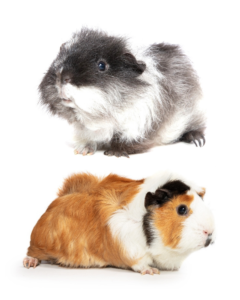 Nemo and Dory the female guinea pigs were brought to us in April after being abandoned on the side of the road. The poor girls were in a terrible state, living in a small, dirty cage.
Nemo and Dory the female guinea pigs were brought to us in April after being abandoned on the side of the road. The poor girls were in a terrible state, living in a small, dirty cage.
The pair were both suffering from a major mite infestation, causing Dory to chew her back raw, so we swiftly gave them mite treatment. Nemo also had a fungal infection and dandruff, and both guinea pigs had cracked, dry and swollen skin on their feet.
The girls needed specialist care, so we reached out to Porsche from Porsches Rescue to see if she could help rehabilitate and rehome Nemo and Dory. Porsche’s Rescue always does an amazing job with pocket pets and has a great success rate of rehoming guinea pigs.
Porsche took Nemo and Dory on with open arms and was quick to get them back in good health. In her care, Nemo’s fungal infection and dandruff cleared up and Dory’s wounds healed, allowing her fur to grow out.
Before going up for adoption, Nemo and Dory were placed in quarantine to heal and ensure they weren’t pregnant. Turns out they’re just a bit chunky…
The girls both have the most calm and placid nature, so after a little bit of patience, they were adopted into their forever home!
Nemo and Dory’s situation highlights how important it is to provide guinea pigs with appropriate living conditions, to avoid stress and vulnerability to all sorts of illness. With the help of our Animal Care Manager & Veterinarian Dr Renae Jackson and a few tips from Porsches Rescue, we’ve put together a guide to guinea pig housing and enrichment, feeding, and health and veterinary care.
Housing and Enrichment
A hutch/cage serves as the basis for guinea pig housing, but they are temporary enclosures only. It is important that guinea pigs are given an opportunity to exercise outside of their hutch/cage for a few hours every day in unfiltered natural sunlight. The hutch/cage needs to be safe and secure and provide protection from the elements and predators. For one guinea pig, the cage should be at least 7.5 square feet. For two guinea pigs, 10.5 square foot is recommended.
Indoor enclosures should be secure and kept in a sun-free, low traffic area. Keeping them permanently outdoors is not recommended as they get hot in the warmer months. Guinea pigs can tolerate temperatures between 18C – 20C, anything more than 25C can lead to heat stroke. To help keep them cool in the warmer months, you can:
- house them indoors
- provide lots of fresh water, ice packs/frozen water bottles, damp towels, frozen ice treats
- provide tiles inside the hutch/cage, fan or air conditioner, ice/gel packs.
A hutch/cage needs to be easy to clean so that soiled bedding can be removed daily. As Porsche notes, keeping bedding fresh is important to keep your guinea pigs’ bums dry and clean. The entire hutch should be cleaned at least once or twice a week. Guinea pigs should be given suitable bedding such as hay, straw or shredded paper, which should be changed regularly.
Porsche adds that surfaces like wire or hard flooring can lead to a condition called bumble foot, a very painful infection of the foot pad.
Naturally, guinea pigs live in groups and in burrows underground either dug by themselves or other animals. It’s a good idea to provide your guinea pig with a similar form of ‘safe’ place, so they can hide in their ‘burrow’ if they feel frightened. A burrow can be simulated in the form of an upturned box or a covered corner of the room. These safe holes help the guinea pig to feel more secure in their environment. Guinea pigs will also love some toys to play with; wooden toys, tunnels and balls can be great!
Guinea pigs can be trained to use a litter tray or a particular toilet area. Suitable litter material includes hay, straw and some cat litters (avoid clay types). This will have to be changed regularly.
If your guinea pig is having a free play, ensure your home is guinea pig-proofed; they can chew electrical cords and hide well!
Feeding
It is vital that your guinea pig has adequate nutrition that is high in fibre. Providing a good quality grass hay (timothy or oaten), and fruit and vegetables (one cup per day) will ensure your guinea pig is provided with enough minerals and nutrients. They like capsicum, coriander, kale, cos lettuce and leafy greens. Always check the nutritional content of any pellet/mixes.
Health and Disease Prevention
While they don’t need regular vaccinations, routine veterinary examinations are a must for guinea pigs. Even if your guinea pig isn’t exhibiting signs of malaise or pain, it’s crucial to take them in for a veterinary examination at least once every 12 months. It’s also important to take your guinea pig to the vet if it’s injured or if anything else seems different in terms of behaviour or health. Some signs that may indicate illness or pain in your guinea pig include:
- runny discharge of the nose or eyes
- abnormal bleeding
- changes in water consumption patterns
- bloody urine
- problems breathing
- diarrhoea
- rapid weight gain or loss
- decreased body temperature
- contact sensitivity
- lethargy
- decreased energy
- irregularities with the skin
- difficulty walking
- swelling.
It is recommended you take your guinea pig to a specialist vet for desexing and microchipping. Desexing reduces aggression, urine spraying and mammary cancers. It will prevent also prevent unwanted pregnancies as guinea pigs can start to breed at 4 weeks old.
If you intend to keep more than one guinea pig (they are very social animals and love having companions), suitable mixes include:
- one male and one female (only if they are desexed)
- two desexed males or females.
It is not advisable to mix guinea pigs with rabbits as they can bully each other and transfer diseases to each other. You should make an effort to bond your guinea pigs through slow introductions. Further research on this subject will start you off on the right track.
As with any pet, owning a guinea pig is a commitment of love, energy, time and resources, and that involves everything from regular interaction, veterinary care and beyond. But as any guinea pig owner would know, when you give them the care they need, they pay you back tenfold with their fun, loveable personalities!
Senior Pet Project: Long Road to Recovery
14-year-old Primrose came into the Home in May as skin and bones with patchy fur and a severe live flea infestation. Her skin was irritated all over, so we immediately jumped to action, administering flea prevention to swiftly kill the fleas.
With her skin under control, Primrose then underwent a thorough health check, when we discovered she had a cyst on her lip, impacted anal sacs, matted fur around her back end and major dental disease, with a lot of her teeth already missing.
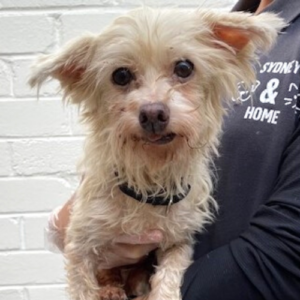 Treatment went underway, with our vet team emptying her anal sacs, giving her a bath, clipping our her matted fur and running blood tests to check for signs of underlying disease, which fortunately came back negative. The team suspected Primrose’s dental disease was so bad, she may have an infection extending to her jaw bone, so she started on a long course of antibiotics.
Treatment went underway, with our vet team emptying her anal sacs, giving her a bath, clipping our her matted fur and running blood tests to check for signs of underlying disease, which fortunately came back negative. The team suspected Primrose’s dental disease was so bad, she may have an infection extending to her jaw bone, so she started on a long course of antibiotics.
While we waited for her antibiotics to kick in, Primrose was placed into a foster home, where she could recover from her procedures and get ready for major dental surgery.
When Primrose came back in for a recheck in June, she was very itchy around her hind end. While she didn’t have any fleas, it appeared she was suffering from flea allergy dermatitis, an allergic reaction to her original flea bites.
The medication continued. Primrose was prescribed a steroid to suppress the inappropriate immune reaction and a new type of antibiotics suited to skin bacteria.
Two weeks later, Primrose was finally ready for her dental surgery. Her diseased teeth were removed, leaving onto one healthy tooth behind.
Primrose healed well and one week later, underwent desexing surgery and a procedure to remove her lip cyst. During the surgery, the team found a cyst on one of Primrose’s ovaries, so both her cysts were sent off to pathology. Luckily, they were both benign.
After over $1,100 worth of treatment, things were finally looking up for Primrose, and she went up for adoption.
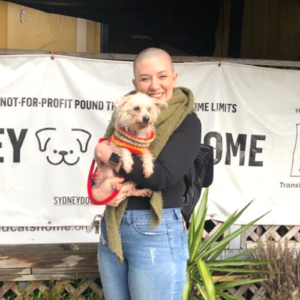 Primrose was adopted in June by Elle and has been settling really well in to her forever home. She’s even made friends with her ex-battery hen housemate! Her fur has filled out, she’s gained weight and she has the most endearing gummy smile.
Primrose was adopted in June by Elle and has been settling really well in to her forever home. She’s even made friends with her ex-battery hen housemate! Her fur has filled out, she’s gained weight and she has the most endearing gummy smile.
Primrose has gotten really close with her mum and despite only having one tooth, is loving all the new foods she’s been sampling. Elle told us: “She’s the most wonderful girl and I treasure every day that I have with her. I remind her daily that I love her and she simply MUST live forever.”
As Sydney’s only charity pound and community facility, we rely on donations to give senior pets a second chance in life. Donate today to the Senior Pet Project to give pets like Primrose the care and treatment they need to thrive in their twilight years.
ABOUT THE SENIOR PET PROJECT
In its second year, our Senior Pet Project was started as an initiative not only to put a spotlight on golden oldies to help with their rehoming, but also to raise the funds required for their much needed veterinary care and often prolonged stay at the Home.
With your support we are looking to raise $50,000 to help fund the Senior Pet Project in the months ahead, enabling us to give the seniors entering our care a new leash on life.
Senior Pet Project: Crumpet the Foster Fail
Crumpet came to us in April, made weary by his time on the streets. The 10-year-old gentleman had no ID and initially appeared to be suffering arthritis, a cyst on the back of his neck and dental disease.
To get to the bottom of his ailments, we did a blood test and x-rays, finding he had moderate dental disease, an area of resorbed bone in the lower jaw and arthritis of the spine, hips and elbows. Otherwise, he was a healthy cat.
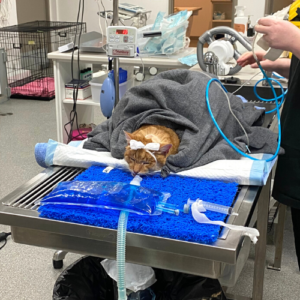 Our vet team were concerned Crumpet’s jaw issue might indicate cancer, so a bone biopsy sample was sent to pathologists. Thankfully, no cancer was found, with his results indicating a bone infection, which was easily treated with antibiotics
Our vet team were concerned Crumpet’s jaw issue might indicate cancer, so a bone biopsy sample was sent to pathologists. Thankfully, no cancer was found, with his results indicating a bone infection, which was easily treated with antibiotics
Crumpet underwent a major dental procedure, complete with a scale and polish, in addition to cyst removal from his neck.
Crumpet was fortunate to have a wonderful foster carer Alicia, who helped him recover post-surgery, and monitored his arthritis for signs of improvement while on pain relief. Crumpet’s energy improved and his back legs stopped shaking, indicating major improvements in comfort and quality of life.
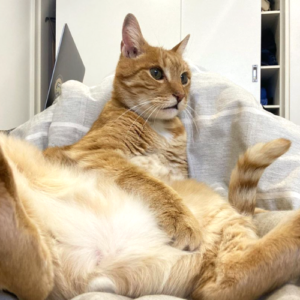 Meanwhile, Alicia was growing quite fond of Crumpet. She’d fostered several pets before and is normally a dog-person, so thought fostering cats would make it easier to let go. Crumpet proved her wrong!
Meanwhile, Alicia was growing quite fond of Crumpet. She’d fostered several pets before and is normally a dog-person, so thought fostering cats would make it easier to let go. Crumpet proved her wrong!
Crumpet became a ‘foster fail’, meaning he was adopted by his foster carer. We’re told he’s doing really well in his forever home and loves cuddling and spending time with his people. What a wonderful way to retire!
Crumpet now has his very own Instagram, where you can follow his forever home adventures. Check it out @crumpelstiltskin_cat.
As Sydney’s only charity pound and community facility, we rely on donations to give senior pets a second chance in life. Donate today to the Senior Pet Project to give pets like Crumpet the care and treatment they need to thrive in their twilight years.
ABOUT THE SENIOR PET PROJECT
In its second year, our Senior Pet Project was started as an initiative not only to put a spotlight on golden oldies to help with their rehoming, but also to raise the funds required for their much needed veterinary care and often prolonged stay at the Home.
With your support we are looking to raise $50,000 to help fund the Senior Pet Project in the months ahead, enabling us to give the seniors entering our care a new leash on life.
Senior Pet Project: Buckley’s Big Surgeries
Buckley the 13-year-old Chinese Crested Powderpuff came to us looking a bit defeated. He had eye discharge crusted and matted into his fur, his ears were inflamed and full of discharge, his whole body was covered in dermatitis, he had a heart murmur and though his mouth was too painful to inspect, he appeared to have severe dental disease. It was desperate times for sweet Buckley.
Our vet team were very concerned for Buckley’s welfare and on his arrival, cleaned up his eyes and started him on medicated shampoo for his skin. He was so itchy he’d been chewing his hind end red raw, so we gave him a cream to sooth his sores.
Our vet team suspected Buckley’s heart murmur was due to mitral valve degeneration, which is common amongst older, small breed dogs. Buckley was booked in for an ultrasound to investigate further, and ensure it would be okay to anaesthetise him for surgery. This scan was done by a specialist, who found he did indeed have mitral valve disease, however there were no secondary changes to suggest he required medication at this stage. Eventually, this disease can lead to heart failure, but affected dogs can still live a good quality of life for several years after a heart murmur develops.
Buckley’s scans showed it was safe for him to receive anaesthesia, so he underwent surgery for his dental disease, which required multiple tooth extractions. His ears were also flushed and his prostate checked. He was found to have very full anal sacs, and a potential mass on his right sac. After a further investigative surgery, the mass was confirmed and sent to pathology, hoping it was simply a benign tumour. Unfortunately, the pathology results showed Buckley has anal sac adenocarcinoma, a locally invasive cancer, which will only give him six months to one year to live.
Even with mitral valve disease and cancer, with minimal symptoms present, Buckley can now enjoy a comfortable retirement and live up to 14 years old with proper monitoring and treatment. We are currently arranging a forever home where he can receive palliative care and retire in comfort.
Since Buckley arrived he’s had a safe place to rest, relax and receive around-the-clock care. It took a little searching, but we found the perfect foster carer Samantha, who had experience medicating and caring for an older dog, and a home environment where Buckley could be closely monitored.
Samatha tells us Buckley bounced back from his surgeries like a champ, and despite all the stitches in his gums, has a huge appetite. He’s gradually become more relaxed, happy and healthy in her family’s care, and has even been learning some new tricks, like sit and lie down.
Like many of the senior pets in our care, Buckley has required extra veterinary treatment and a prolonged stay at the time, costing us over $1,200. It’s only thanks to our wonderful donors we can afford to give Buckley this second chance at life.
Donate today to the Senior Pet Project to give pets like Buckley the care and treatment they need to thrive in their twilight years.
ABOUT THE SENIOR PET PROJECT
In its second year, our Senior Pet Project was started as an initiative not only to put a spotlight on golden oldies to help with their rehoming, but also to raise the funds required for their much needed veterinary care and often prolonged stay at the Home.
With your support we are looking to raise $50,000 to help fund the Senior Pet Project in the months ahead, enabling us to give the seniors entering our care a new leash on life.
Senior Pet Project: Senior Surrender
Eight-year-old Jellico has done a lot of moving around this past year. His owners had moved and passed him onto family in Armidale, but unfortunately it turned out one of his new humans was very allergic to cats. This didn’t work very well for Jellico as he likes to get up close and personal with his people.
Jellico’s new owners wanted to do the right thing and find a rescue who could put him in a forever home. Unfortunately, at the time, no one could take him in. Jellico’s owners waited several months before finding a local rescue, who was then able to transfer him to us for rehoming when a space opened up at our shelter. We drove to Armidale to collect him.
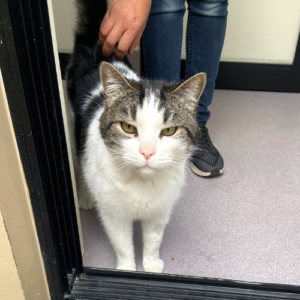 Jellico was one of the lucky ones – he didn’t require any surgery. He was already desexed and otherwise looked healthy. Because he was an older cat, our vet team checked his blood – and lucky they did. We discovered he had mild anaemia.
Jellico was one of the lucky ones – he didn’t require any surgery. He was already desexed and otherwise looked healthy. Because he was an older cat, our vet team checked his blood – and lucky they did. We discovered he had mild anaemia.
The team did a faecal test and started him on a worming treatment to see if parasites were causing his anaemia. Following this treatment, Jellico’s anaemia began to improve, returning to normal levels, and he was finally ready for his forever home.
Jellico is an affectionate, cuddly boy, but as a senior, it took him a little while to find a new family. Luckily, one month after his arrival, a very eager adopter came along and scooped him off his fluffy feet.
As Sydney’s only charity pound and community facility, we rely on donations to give senior pets a second chance in life. Donate today to the Senior Pet Project to give pets like Jellico the care and treatment they need to thrive in their twilight years.
ABOUT THE SENIOR PET PROJECT
In its second year, our Senior Pet Project was started as an initiative not only to put a spotlight on golden oldies to help with their rehoming, but also to raise the funds required for their much needed veterinary care and often prolonged stay at the Home.
With your support we are looking to raise $50,000 to help fund the Senior Pet Project in the months ahead, enabling us to give the seniors entering our care a new leash on life.
Archives
- February 2025
- January 2025
- August 2024
- July 2024
- June 2024
- April 2024
- February 2024
- January 2024
- October 2023
- September 2023
- August 2023
- June 2023
- March 2023
- February 2023
- January 2023
- December 2022
- November 2022
- October 2022
- September 2022
- June 2022
- May 2022
- March 2022
- February 2022
- December 2021
- November 2021
- October 2021
- September 2021
- July 2021
- April 2021
- March 2021
- February 2021
- January 2021
- December 2020
- November 2020
- October 2020
- September 2020
- August 2020
- June 2020
- May 2020
- April 2020
- January 2020
- November 2019
- October 2019
- September 2019
- August 2019
- July 2019
- June 2019
- May 2019
- March 2019
- January 2019
- November 2018
- October 2018
- September 2018
- August 2018
- July 2018
- June 2018
- May 2018
- April 2018
- February 2018
- January 2018
- December 2017
- November 2017
- October 2017
- September 2017
- August 2017
- May 2017




 MON-SUN:
MON-SUN:
 02 9587 9611
02 9587 9611 INFO@SYDNEYDOGSANDCATSHOME.ORG
INFO@SYDNEYDOGSANDCATSHOME.ORG






